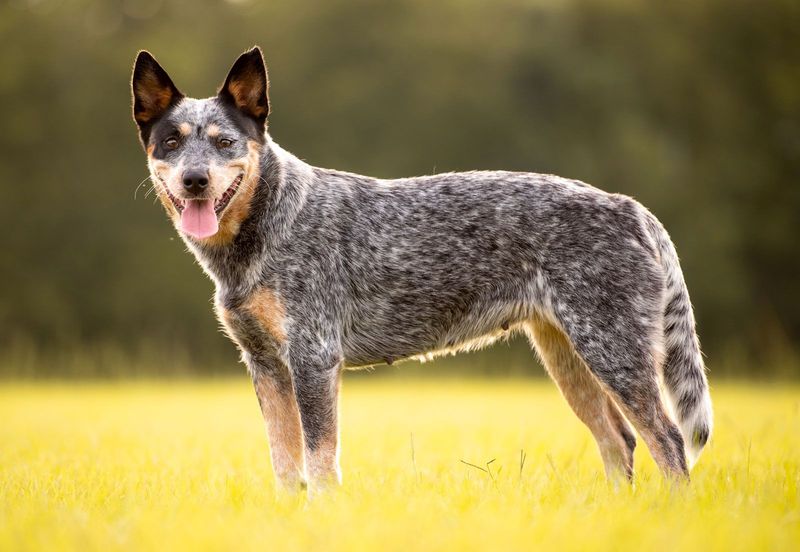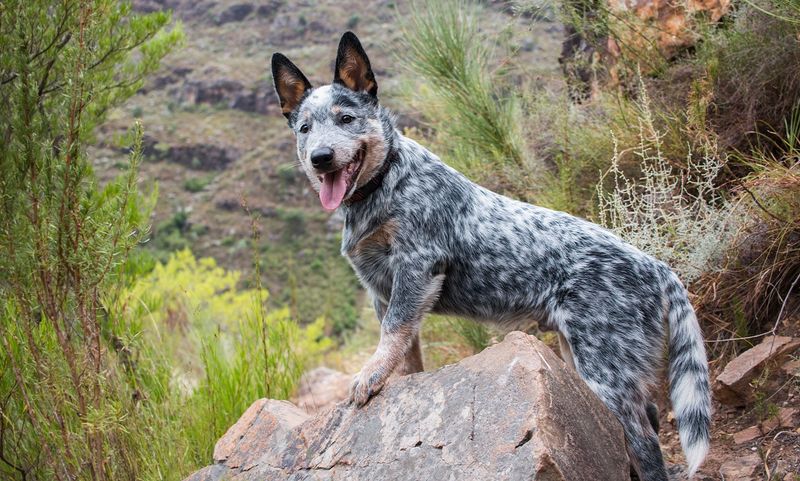Australian Shepherd VS Australian Cattle Dog: What Are The Differences?

The Australian Shepherd and the Australian Cattle Dog often confuse those unfamiliar with these lively breeds.
Despite sharing a continent in their names, they hail from different backgrounds and possess unique characteristics.
So, let’s explore the fascinating differences between these two breeds, offering insights into their appearances, temperaments, and histories.
1. Origin And History

The Australian Shepherd, contrary to its name, originated in the United States in the late 19th century. It was bred to herd livestock and became a staple on ranches across America.
Its misleading name stems from the association with Basque shepherds who arrived in the United States from Australia. The breed’s development was heavily influenced by breeds like the Border Collie and various Spanish herding dogs.
On the other hand, the Australian Cattle Dog truly hails from Australia. Developed in the 19th century, it played a vital role in herding cattle across the challenging Australian Outback.
This breed owes its existence to a mix of British working dogs and the native Australian Dingo, providing resilience and tenacity. Its historical purpose ensured it could endure long hours and harsh conditions.
While both breeds are excellent herders, their histories highlight different developmental paths influenced by distinct geographical and environmental needs.
Understanding their origins provides a window into their behavioral traits and working capabilities, essential knowledge for potential owners.
2. Physical Appearance

The Australian Shepherd is renowned for its striking appearance, often boasting a medium-length coat that comes in various colors like merle, black, blue, and red.
It has a robust and agile build, medium to large size, and expressive eyes that may be blue, brown, or even one of each. The coat is weather-resistant, offering protection in diverse climates, and its tail is often naturally bobbed or docked.
In contrast, the Australian Cattle Dog is more compact and muscular, reflecting its hardy working heritage. It has a short, dense coat that typically appears in blue or red speckled patterns, offering protection from the harsh Australian sun.
Its ears stand alert, ready to catch any sound, and its eyes are sharp and intelligent, often conveying a keen sense of awareness. These physical distinctions are not merely aesthetic; they reflect the unique environments these breeds were developed to thrive in.
The differences in their appearances highlight their specialized roles and the evolutionary paths that have shaped them, demonstrating how form meets function in the world of canine companions.
3. Temperament And Behavior

Australian Shepherds are celebrated for their friendly and affectionate nature. They thrive on human interaction, making them excellent family companions. Known for their intelligence and eagerness to please, they excel in obedience and agility training.
However, their active minds require constant stimulation to prevent boredom, which may lead to mischievous behavior. On the flip side, Australian Cattle Dogs are more independent, reflecting their working dog roots.
They demonstrate unwavering loyalty but may be wary of strangers, needing proper socialization from a young age. These dogs have a strong herding instinct and may try to herd other animals or even children, a trait stemming from their traditional roles.
Both breeds exhibit remarkable intelligence, but their temperaments cater to different lifestyles. Where the Australian Shepherd seeks companionship and mental engagement, the Australian Cattle Dog thrives in environments where it can work and stay active.
Understanding these behavioral traits ensures owners can provide the environments these dogs need to flourish.
4. Energy Levels And Exercise

The energy levels of the Australian Shepherd are nothing short of remarkable. These dogs require daily exercise that goes beyond a simple walk around the block.
Engaging activities such as hiking, running, or playing fetch are ideal to keep them satisfied. Their enthusiasm for physical activities makes them excellent companions for outdoor enthusiasts who can match their pace.
In comparison, the Australian Cattle Dog, with its boundless stamina, is equally energetic but possesses a more intense focus on tasks. This breed thrives in environments where they can work, such as farms or ranches, where their natural herding instincts can be put to good use.
Continuous mental and physical stimulation is essential, as it keeps their agile minds engaged and prevents restlessness. Providing sufficient exercise for both breeds is crucial to their well-being, yet their exercise requirements align with their historical purposes.
While the Australian Shepherd may enjoy a variety of activities, the Cattle Dog often prefers structured tasks that challenge its intellect, showcasing the unique energy dynamics of these vibrant breeds.
5. Training And Intelligence

Training an Australian Shepherd is often a rewarding experience due to their innate intelligence and eagerness to learn. These dogs excel in obedience and agility exercises, making them favorites in competitive canine sports.
Their ability to understand complex commands and willingness to cooperate greatly enhances the training process, though consistent engagement is key to maintaining their interest.
Australian Cattle Dogs, renowned for their problem-solving skills, approach training with a determined mindset. While they might not seek approval in the same way as the Australian Shepherd, their intelligence shines in tasks that require critical thinking, such as herding trials.
They benefit from firm but positive training methods, which utilize their natural instincts and offer challenges to keep them occupied. Both breeds thrive on training, yet their distinct approaches reflect their working backgrounds.
Where Australian Shepherds might enjoy a playful training session, Cattle Dogs require structure and purpose. Recognizing these differences allows owners to tailor their training techniques, ensuring both breeds reach their full potential and remain mentally stimulated.
6. Health And Lifespan

The health and lifespan of both the Australian Shepherd and Australian Cattle Dog are shaped by their genetics and active lifestyles. Australian Shepherds typically live between 12 to 15 years, with common health issues including hip dysplasia and certain eye conditions.
Regular veterinary check-ups and a balanced diet contribute significantly to their well-being and longevity. Australian Cattle Dogs, with a similar lifespan ranging from 12 to 16 years, are known for their robust health, although they can also suffer from hip dysplasia and progressive retinal atrophy.
An active lifestyle is vital, as it helps maintain their physical health and supports their energetic disposition. Both breeds benefit from proactive health management, which includes regular exercise and mental stimulation, ensuring they lead fulfilling and healthy lives.
Anticipating potential health issues and addressing them promptly enables these dogs to enjoy their senior years with vitality, reflecting the enduring spirit of these cherished companions.






